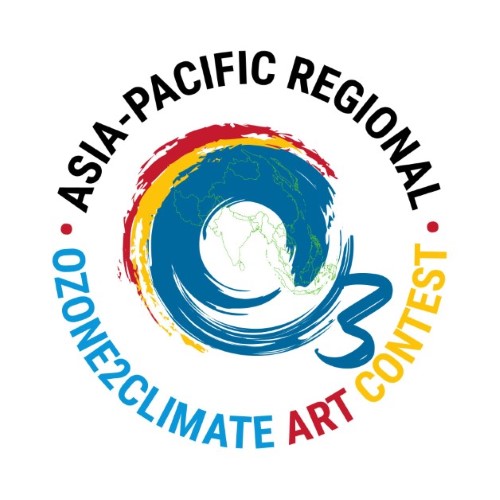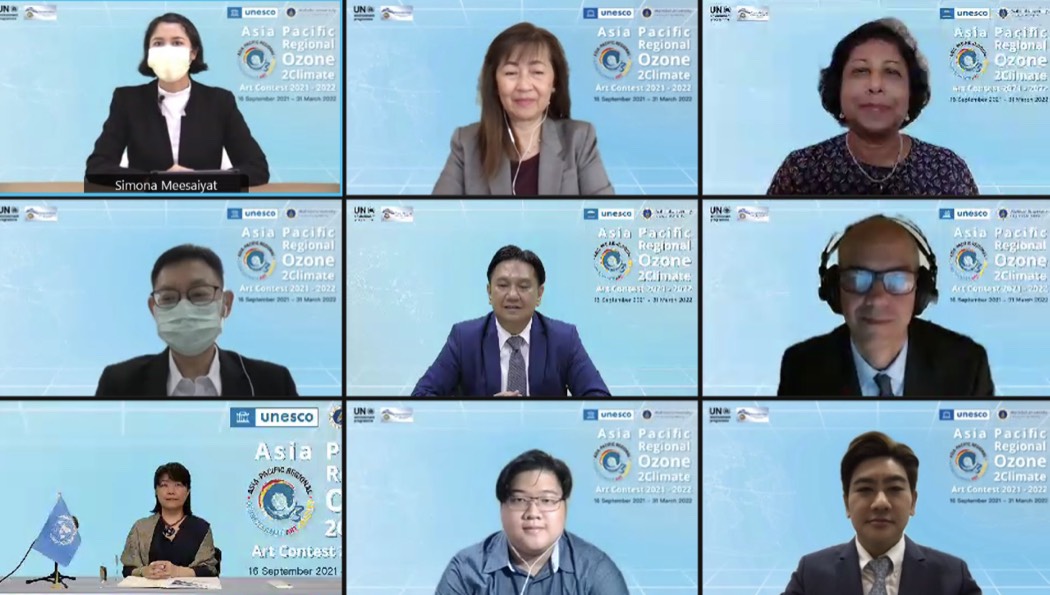
UN Launched The Asia-Pacific Regional Ozone2Climate Art Contest Using Art to Protect Earth’s Ozone Layer and Climate System
The Asia-Pacific Regional Ozone2Climate Art Contest was launched to promote the linkage of ozone layer and climate protection under the Montreal Protocol. Over 30 countries in the Asia Pacific region are participating in this event, under which each country will organise its own national competition, the winners of which will be entered into a regional-level contest. The overall initiative is being jointly organised by the United Nations Environment Programme (UNEP) and the United Nations Educational, Scientific and Cultural Organization (UNESCO), and supported by Mahidol University. The art contest includes three categories – photography, drawing, and graphic design – and it aims to raise the awareness of people in the region about ozone layer depletion and its linkage with climate change.
“The Montreal Protocol under Substances that Deplete the Ozone Layer is one of the most successful multilateral environmental agreements in history, which not only enabled the recovery of the ozone layer, but also made significant contributions to climate change mitigation,” said Megumi Seki, Executive Secretary of UNEP’s Ozone Secretariat. She further added, “with full implementation of the Kigali Amendment, the Montreal Protocol could avoid a 0.4-degree Celsius global temperature increase by the end of the century. Further, the Montreal Protocol will also inspire the global fight against climate change.” Noting that the theme for this year’s World Ozone Day is ‘Montreal Protocol: Keeping Us, Our Food and Vaccines Cool’, she expressed her full support for this regional contest.
The term ‘Ozone2Climate’ used in the contest title reflects the linkage between ozone layer and climate issues from different perspectives, including those related to the science, technology, and management approach. James S. Curlin, Head of UNEP OzoneAction, highlighted the role of industry and the public for the promotion of safe alternative technologies to replace ozone depleting substances and high-global warming potential refrigerants and called for “everybody in the Asia-Pacific region and world at large to take action and play their role,” noting especially that ” the procurement power of the public will guide the market to favor Ozone2Climate products.” He also appreciated that countries in the region are making efforts to jointly conduct the artwork contest, despite the global COVID-19 pandemic which poses a challenge for all countries to conduct their planned awareness-raising activities and demonstrates their commitment to collaboratively solve problems.
Ms. Rika Yorozu, Head of the Executive Office and Regional Programme Coordinator for UNESCO Bangkok highlighted that the ‘Asia-Pacific Regional Ozone2Climate Art Contest’ offers an excellent opportunity to foster creativity for peace and sustainable development, which is at the heart of UNESCO’s missions. The contest also encourages practicing an integrated learning curriculum combining scientific understanding with creative thinking and expression which are important skills for today’s youth. She pointed out the degradation of the ozone layer provides a powerful example of how changes in human behavior can have a positive effect in reversing climate crisis. This art contest will help raise awareness of the significant role that ozone layer plays in our everyday lives and she invited young people, especially girls and women across the region to participate. UNESCO is fully on board to promote this initiative through its various networks, notably UNESCO Associated Schools and UNESCO designated sites; Biosphere Reserves, World Heritage sites and UNESCO Global Geoparks in the Asia-Pacific.
Mr. Jackrit Suthakorn, Dean of the Faculty of Engineering, Mahidol University, a supporting partner of the regional contest, talked about the roles of educational institutions to encourage youths to be engaged and become better informed about environmental issues, including ozone layer depletion and climate change, and to support innovative research that will protect the environment. He inaugurated the dedicated website for the Asia Pacific Ozone2Climate Art Contest as well as the social media toolkit the University has developed to help countries promote the event at the country and regional levels.
Mr. Alex Rendell, UNEP’s National Goodwill Ambassador for Thailand, spoke about the activities and choices in our daily lives which have a direct impact on the ozone layer and the climate. He shared his ideas that the general public could also join to make a difference for the protection of the ozone layer and climate. He invited everyone to join the Asia-Pacific Ozone2Climate Art Contest to share their ideas about how ozone layer depletion and climate change can be solved. He emphasized that we should take action together to save our ozone layer and cool down our earth’s temperature.
Out of 38 developing countries in the Asia Pacific region, Bangladesh, Bhutan, Cambodia, China, Cook Islands, Fiji, India, Indonesia, Iran, Kiribati, Republic of Korea, Lao PDR, Malaysia, Maldives, Marshall Islands, Micronesia, Mongolia, Myanmar, Nauru, Niue, Palau, Pakistan, Papua New Guinea, Philippines, Samoa, Solomon Islands, Sri Lanka, Thailand, Timor-Leste, Tonga, Tuvalu, Vanuatu and Viet Nam have already confirmed their participation in the Asia-Pacific Regional Ozone2Climate Art Contest, and more countries are expected to confirm their participation soon. Entries will be accepted until 31 March 2022. During World Ozone Day 2022, the winner at both the country and regional levels will be announced following a transparent and consistent evaluation process.
The competition is being organized as part of the Asia-Pacific Regional Networks of Ozone Officers, as part of UNEP’s workplan under the Montreal Protocol’s Multilateral Fund.
For more information about the contest, please visit: www.ozone2climate.org;
Email:[email protected]
Source: Brainasia Communication
